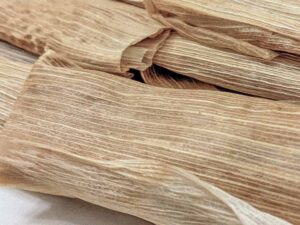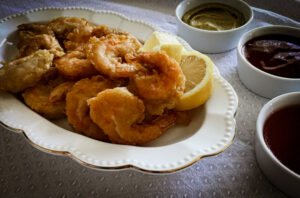Preserving a Simple Applesauce for Winter

Mrs. April Jaure
I didn’t grow up canning — my parents didn’t grow any of our food, although my father and brothers occasionally brought home game after hunting in the cold mountains of Wyoming — but, as an adult living in the Midwest, with its numerous farmers markets, CSAs, and hot, humid summers (wonderful for gardening), I took it up.
At first canning seemed a bit intimidating, and some people warned me off of it, saying that it was too difficult. It does take a bit of planning to get all the canning supplies and set things up in the kitchen, but it’s an easy and enjoyable process if
done right.
This year, my family picked apples at an orchard. I decided to preserve some applesauce. Because I want to minimize the sugar that my family consumes, and because applesauce is sweet enough for us without sugar, I did not add any. You can add sugar or cinnamon if you wish, but I prefer just plain old applesauce! Whatever food you decide to preserve, be sure to follow a canning recipe and the instructions for canning that particular food.
— April
What You Need

Canning supplies:
• Stock pot with well-fitting lid and metal trivet for bottom of pot (or a water bath canner with rack)
•Mason jars (3 lbs of apples will yield approximately 2 pints of applesauce)
•New canning lids
•Mason jars and rims
• Tools — lid lifter, canning funnel, jar lifter, and kitchen tongs
Applesauce supplies:
•Potato masher
•Hand-held immersion blender or food processor to make smooth applesauce (unless you like your sauce to be a little chunky!)
•Optional: apple corer, good vegetable peeler
Ingredients:
•Apples & Lemon Juice
What You Do



The first step is, as the French say, mise en place. That is, make sure you have all your ingredients and materials handy. Also, take some time to set up your workstation to allow for a smooth canning experience. What burner will the apples be cooked on? Where will the jars be placed to fill with the applesauce? The canning supplies will need to be nearby.
You’ll want to sanitize Mason jars by placing them in simmering water for a minimum of ten minutes.
Meanwhile, core and peel apples and cut into fourths or eighths. To prevent browning, place in a bowl of water with 1/4 cup of lemon juice for every one cup of water.
Place sliced apples into a pot with a couple of inches of water in the bottom. Cover with lid and heat on medium-high heat for ten to fifteen minutes. If needed, you can add more water, but be careful as you do not want runny applesauce. It may take less or more time depending on the type and quantity of apples you are heating, as well as the maturity of the apples when they were picked.
While the applesauce is cooking, place the metal trivet in the bottom of your stock pot and fill the pot with water and bring to a boil. Remember that once the filled jars are placed in the pot, they will displace some of the water, however, once all the jars are in, they will also need to be fully submerged with at least an inch of water over their tops. Estimate the water depth accordingly. One tip is to prepare a tea kettle with boiling water just in case you need to add more boiling water to the pot. If you add too much water initially, you can simply ladle some out as needed.
Wash the canning lids well with soap and water and set aside.
Once all the apple slices are soft enough to be mashed with a fork or potato masher, they are ready. Add one tablespoon of lemon juice for every three pounds of apples you used. Mash well with potato masher, then use a hand-held immersion blender to get really smooth applesauce. You can also use a food processor to blend the applesauce by working in batches. You want hot applesauce to place in the jars, so if you use a food processor, return the applesauce to the pot and keep at a simmer until all the applesauce is ready to be put in the jars.
Next, remove hot jars from the dishwasher or the pot where they have been simmering (this could be the same pot in which the filled jars will be processed). Using a canning funnel, ladle hot applesauce into the hot jars, leaving 1/2 inch headspace.
Remove air that may be trapped in the jar by running a plastic knife or non-metallic spatula (or the end of your lid lifter) along the inside of the jar. Wipe the rim with the clean, damp dishcloth. Place lid on jars, and screw on rims until they are finger tight, that is, not loose, but not overly tight.
Using the jar lifter, place jars into the boiling water bath. (In my twelve-quart stock pot, seven pint-size jars fit perfectly.) Boil for twenty minutes. Remove from heat and allow to sit in hot water for another five minutes.
Using the jar lifter once more, remove jars from the water bath and place on the counter. Allow to sit undisturbed for twelve hours. You may hear a pop as the lids seal.
The next day, check to make sure all the jars are sealed. When you press down in the center of the lid with your finger, there should be no give. If the lid pops up, then you will need to refrigerate the applesauce and use within a week, but otherwise the jars can be labeled with contents and date and stored for a year.
I began with about nine pounds of apples and canned seven pints of applesauce. It isn’t much for my family of six, but I’m happy that I will have to buy a few fewer pints of applesauce this winter. I am also looking forward to topping a jar or two with some pretty fabric and sharing them with friends and family.
Finally, don’t be afraid, but don’t be stupid. Humans have been preserving food for millenia, but our immune system is no better at dealing with food-born illness than it was millenia ago. Take care to be clean when you preserve your food. If any of your preserves swell in the jar, explode, or smell off-putting, discard the contents of that jar and don’t eat it.



















